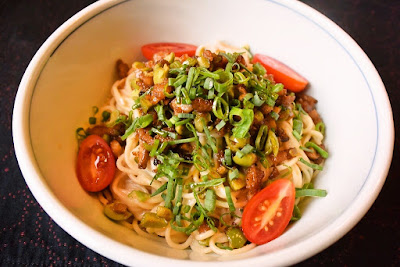Okara-konnyaku is a hybrid of
okara soybean pulp (rich in soluble fiber) and
konnyaku yam cake (rich in non-soluble fiber), and has been around for more than a decade in Japan. It is mainly used as a meat substitute for health, weight loss and diet preference reasons. As with
konnyaku,
okara-konnyaku becomes very chewy after being frozen and defrosted. While
konnyaku simply become fibrous after the same process or tofu becomes spongy (like
koyadofu freeze-dried tofu after rehydration),
okara-konnyaku takes on a meaty texture. Among dishes I have tried, it seems to work best when used like ground meat, especially poultry and pork. Because it is basically fiber, it is very filling by itself. Moreover, it does not cause any heartburn or upset stomach in people who are not accustomed to eating meat, such as myself. This would be a great option for those who routinely eat meat and want to cut back to reduce fat or calories or for other health reasons. You would not notice that your hamburger patties or meat loaf contains
okara-konnyaku if the proportion is moderate.
You can find a number of preparation methods and ingredient proportions. Below is my current standard way of making
okara-konnyaku at home.
100 g okara-konnyaku, boiled:
52 calories; 2.6 g protein; 1.4 g fat; 8.5 g carbohydrate; 2.0 g net carbs; 3 mg sodium; 0 mg cholesterol; 6.5 g fiber
100 g okara-konnyaku, defrosted:
63 calories; 3.1 g protein; 1.7 g fat; 10.4 g carbohydrate; 2.5 g net carbs; 3 mg sodium; 0 mg cholesterol; 7.9 g fiber
100 g okara-konnyaku, excess water removed:
86 calories; 4.3 g protein; 2.3 g fat; 14.0 g carbohydrate; 3.3 g net carbs; 4 mg sodium; 0 mg cholesterol; 10.7 g fiber










